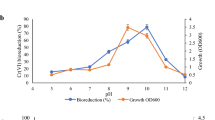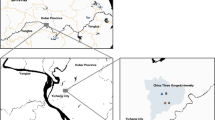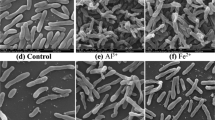Abstract
Pollution of terrestrial surfaces and aquatic systems by hexavalent chromium, Cr(VI), is a worldwide public health problem. A chromium resistant bacterial isolate identified as Exiguobacterium sp. GS1 by 16S rRNA gene sequencing displayed high rate of removal of Cr(VI) from water. Exiguobacterium sp. GS1 is 99% identical to Exiguobacterium acetylicum. The isolate significantly removed Cr(VI) at both high and low concentrations (1–200 μg mL−1) within 12 h. The Michaelis–Menten K m and V max for Cr(VI) bioremoval were calculated to be 141.92 μg mL−1 and 13.22 μg mL−1 h−1, respectively. Growth of Exiguobacterium sp. GS1 was indifferent at 1–75 μg mL−1 Cr(VI) in 12 h. At initial concentration of 8,000 μg L−1, Exiguobacterium sp. GS1 displayed rapid bioremoval of Cr(VI) with over 50% bioremoval in 3 h and 91% bioremoval in 8 h. Kinetic analysis of Cr(VI) bioremoval rate revealed zero-order in 8 h. Exiguobacterium sp. GS1 grew and significantly reduced Cr(VI) in cultures containing 1–9% salt indicating high salt tolerance. Similarly the isolate substantially reduced Cr(VI) over a wide range of temperature (18–45 °C) and initial pH (6.0–9.0). The T opt and initial pHopt were 35–40 °C and 7–8, respectively. Exiguobacterium sp. GS1 displayed a great potential for bioremediation of Cr(VI) in diverse complex environments.







Similar content being viewed by others
References
Arıca MY, Bayramoglu G (2005) Cr(VI) biosorption from aqueous solutions using free and immobilized biomass of Lentinus sajor-caju: preparation and kinetic characterization. Physicochem Eng A253:203–211
Bartlett RJ, James BR (1996) Chromium. In: Spark DL (ed) Methods of soil analysis Part 3, SSSA Book Series 5, SSSA, Madison, pp 683–701
Bayramoglu G, Celik G, Yalcin E, Yilmaz M, Arica MY (2005) Modification of surface properties of Lentinus sajor-caju mycelia by physical and chemical methods: evaluation of their Cr6+ removal efficiencies from aqueous medium. J Hazard Mater B119:219–229
Camargo FAO, Okeke BC, Bento FM, Frankenberger WT (2005) Diversity of chromium-resistant bacteria isolated from soils contaminated with dichromate. Appl Soil Ecol 29:193–202
Camargo FAO, Okeke BC, Bento FM, Frankenberger WT (2004) Hexavalent chromium reduction by immobilized cells and cell-free extract of Bacillus sp. ES 29. Bioremediation J 8:23–30
Camargo FA, Bento FM, Okeke BC, Frankenberger WT (2003) Chromate reduction by chromium-resistant bacteria isolated from soils contaminated with dichromate. J Environ Qual 32:1228–1233
Camargo FA, Bento FM, Okeke BC, Frankenberger WT (2004) Hexavalent chromium reduction by an actinomycete, Arthrobacter crystallopoietes ES 32. Biol Trace Elem Res 97:183–194
Camargo FA, Okeke BC, Bento FM, Frankenberger WT (2003) In vitro reduction of hexavalent chromium by a cell-free extract of Bacillus sp. ES 29 stimulated by Cu2+. Appl Microbiol Biotechnol 62:569–573
Campos J, Martinez-Pacheco M, Cervantes C (1995) Hexavalent-chromium reduction by a chromate-resistant Bacillus sp. strain. Antonie Leeuwenhoek 68:203–208
Cheung KH, Gu JD (2003) Reduction of chromate (CrO 24 ) by an enrichment consortium and an isolate of marine sulfate-reducing bacteria. Chemosphere 52:1523–1529
Chung J, Nerenberg R, Rittmann BE (2006) Bio-reduction of soluble chromate using a hydrogen-based membrane biofilm reactor. Wat Res 40:1634–1642
Clark DP (1994) Chromate reductase activity of Enterobacter aerogenes is induced by nitrite. FEMS Microbiol Lett 122:233–238
Clifford D, Liu X (1993) Ion exchange for nitrate removal. Amer Water Works Assoc J 85:135–143
Cummings DE, Fendorf S, Singh N, Sani RK, Peyton BM, Magnuson TS (2007) Reduction of Cr(VI) under acidic conditions by the facultative Fe(lll)-reducing bacterium Acidiphilium cryptum. Environ Sci Technol 41:146–152
Das S, Chandra AL (1990) Chromate reduction in Streptomyces. Experientia 46:731–733
Dermou E, Velissariou A, Xenos D, Vayenas DV (2005) Biological chromium(VI) reduction using a trickling filter. J Hazard Mater 126:1–3
Fruhling A, Schumann P, Hippe H, Straubler B, Stackebrandt E (2002) Exiguobacterium undae sp. nov. and Exiguobacterium antarcticum sp. nov. Int J Syst Evol Microbiol 52:1171–1176
Guha H, Jayachandran K, Maurrasse F (2001) Kinetics of chromium (VI) reduction by a type strain Shewanella alga under different growth conditions. Environ Pollut 115:209–218
Gvozdyak PI, Mogilevich NF, Ryl’skii AF, Grishchenko NI (1987) Reduction of hexavalent chromium by collection of strains of bacteria. Microbiologia 55:770–773
Iyer A, Mody K, Jha B (2004) Accumulation of hexavalent chromium by an exopolysaccharide producing marine Enterobacter cloaceae. Mar Pollut Bull 49:974–977
James BR, Bartlett RJ (1984) Plant–soil interactions of chromium. J Environ Qual 13:67–70
Komori KA, Rivas A, Toda K, Ohtake H (1990) A method for removal of toxic chromium using dialysis-sac cultures of a chlomate-reducing strain of Enterobacter cloacae. Appl Microbiol Biotechnol 33:117–119
Krishna KR, Philip L (2005) Bioremediation of Cr(VI) in contaminated soils. J Hazard Mater B121:109–117
Kurniawan TA, Chan GYS, Lo W-H, Babel S (2006) Physico-chemical treatment techniques for wastewater laden with heavy metals. Chem Eng J 118:83–98
Lane D (1991) 16S/23S sequencing. In: Stackebrandt E, Goodfellow M (eds) Nucleic acid techniques in bacterial systematics. John Wiley and Sons, New York, NY
Laxman RS, More S (2002) Reduction of hexavalent chromium by Streptomyces griseus. Miner Eng 15:831–837
Lee DC, Park CJ, Yang JE, Jeong YH, Rhee HI (2000) Screening of hexavalent chromium biosorbent from marine algae. Appl Microbiol Biotechnol 54:445–448
Logan BE, Wu J, Unz RF (2001) Biological perchlorate reduction in high-salinity solutions. Wat Res 35:3034–3038
Losi ME, Amrhein C, Frankenberger WT (1994) Environmental biochemistry of chromium. Rev Environ Contam Toxicol 36:91–121
Losi ME, Amrhein C, Frankenberger WT (1994) Bioremediation of chromate-contaminated groundwater by reduction and precipitation in surface soils. J Environ Qual 23:1141–1150
Losi ME, Frankenberger WT (1994) Chromium-resistant microorganisms isolated from evaporation ponds of a metal processing plant. Water Air Soil Pollut 74:405–413
Lovely DR, Phillips EJP (1994) Reduction of chromate by Desulfovibrio vulgaris and its c3 cytochrome. Appl Environ Microbiol 60:726–728
Mathews CK, Van Holde KE, Ahern KG (1999) Biochemistry, 3rd edn. Benjamin-Cummings Pub Co, San Francisco CA
MyRDP Release 9.50 (http://rdp.cme.msu.edu/misc/rel9info.jsp)
Oh YS, Choi SC (1997) Reduction of hexavalent chromium by Pseudomonas aeruginosa HP014. J Microbiol (Microbiol Soc Korea) 35:25–29
Okeke BC, Giblin T, Frankenberger WT (2002) Reduction of perchlorate and nitrate by salt tolerant bacteria. Environ Pollut 118:357–363
Okeke BC, Frankenberger WT (2003) Biodegradation of methyl tertiary butyl ether (MTBE) by a bacterial enrichment consortia and its monoculture isolates. Microbiol Res 158:99–106
Okeke BC, Laymon J, Crenshaw S, Oji C (2008) Environmental and kinetic parameters for Cr(VI) bioreduction by a bacterial monoculture purified from Cr(VI) resistant consortium. Biol Trace Elem Res 123:229–241
Park D, Yun Y-S, Ahn CK, Park JM (2007) Kinetics of the reduction of hexavalent chromium with the brown seaweed Ecklonia biomass. Chemosphere 66:939–946
Thacker U, Parikh R, Shouche Y, Madamwar D (2006) Hexavalent chromium reduction by Providencia sp. Proc Biochem 41:1332–1337
Vishnivetskaya T, Kathariou S, McGrath J, Gilichinsky D, Tiedje JM (2000) Low-temperature recovery strategies for the isolation of bacteria from ancient permafrost sediments. Extremophiles 4:165–173
Vishnivetskaya TA, Petrova MA, Urbance J, Ponder M, Moyer CL, Gilichinsky DA, Tiedje JM (2006) Bacterial community in ancient Siberian permafrost as characterized by culture and culture-independent methods. Astrobiology 6:400–414
Vishnivetskaya TA, Siletzky R, Jefferies N, Tiedje JM, Kathariou S (2007) Effect of low temperature and culture media on the growth and freeze-thawing tolerance of Exiguobacterium strains. Cryobiology 54:234–240
Acknowledgments
Thanks to Shakena Crenshaw, Jeffery Laymon, Charles Oji, Mark Losi and Pete Hall. This study was in part supported from Auburn University Montgomery faculty grant-in-aid, the School of Sciences start-up fund and a grant from Ecomat Inc CA.
Author information
Authors and Affiliations
Corresponding author
Rights and permissions
About this article
Cite this article
Okeke, B.C. Bioremoval of hexavalent chromium from water by a salt tolerant bacterium, Exiguobacterium sp. GS1. J Ind Microbiol Biotechnol 35, 1571–1579 (2008). https://doi.org/10.1007/s10295-008-0399-5
Received:
Accepted:
Published:
Issue Date:
DOI: https://doi.org/10.1007/s10295-008-0399-5




